Georgia, with its diverse habitats, is home to a wide variety of caterpillars, the intriguing larvae of moths and butterflies. While these wriggly creatures are primarily known for their eventual transformation into beautiful winged wonders, it’s essential to approach them with knowledge and caution. Among the numerous caterpillars found in the state, a few are poisonous, carrying toxins that can cause skin irritations or allergic reactions. For those exploring the Georgia outdoors or simply relaxing in your backyard, it’s crucial to recognize and respect the diverse caterpillar inhabitants and their potential hazards. In this article, we will get to know 20 caterpillars found in Georgia, eight of which are poisonous!
1. Army Cutworm Caterpillar (Euxoa auxiliaris)

Army cutworm caterpillars come in many different colors.
©Frank Peairs, Colorado State University, United States / CC BY 3.0 US – License
After emerging, armyworm caterpillars weave mesh-like shelters within your turf. These protective tunnels enable them to rest hidden in the grass during daylight hours.
Distinct color variations exist among the army cutworm moth. Fully grown army cutworm larvae measure between 1½ and 2 inches. Their color ranges from shades of green to black, with the upper side being darker than the underside. You’ll also be able to observe two distinct stripes on their flanks — one dark and one orange — and a faint white stripe running down their spine.
Like other cutworm species, they are not picky eaters, feeding on a broad range of crops. They also snack on various wild plants and grasses.
Fortunately, cutworms aren’t toxic, posing no threat to humans.
2. Gulf Fritillary Caterpillar (Dione vanillae)
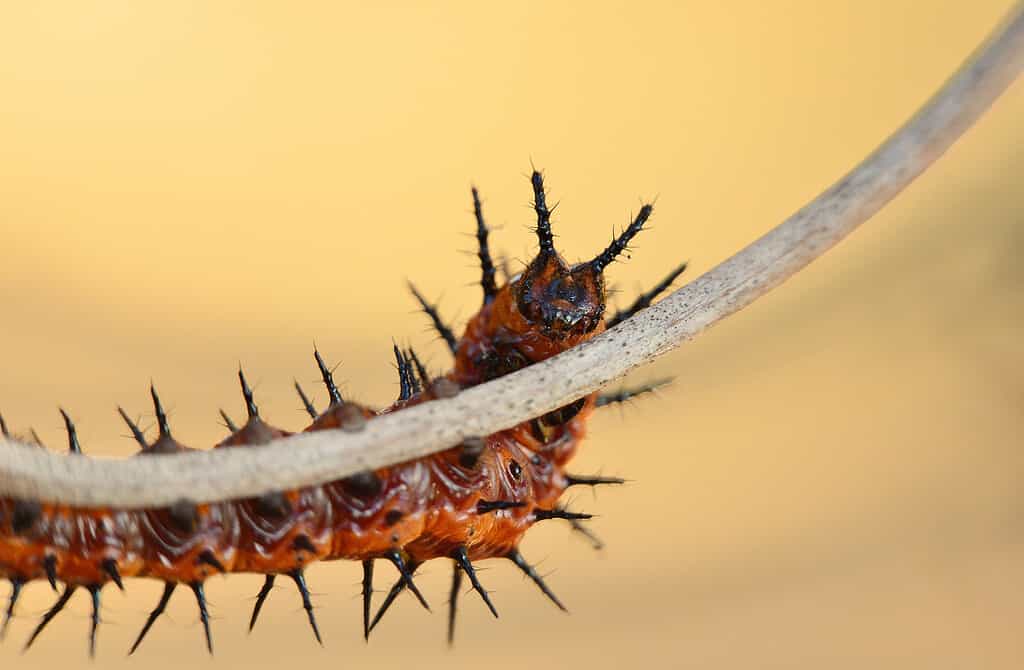
The primary food source of the Gulf fritillary caterpillar is the passion flower.
©Jerry Morse/iStock via Getty Images
The Gulf fritillary is a striking orange butterfly with elongated wings, often linked to the passion butterfly group. These butterflies originate from vibrant yellow eggs, which turn see-through as the little caterpillar inside matures. When fully grown, this caterpillar boasts a vivid orange hue adorned with black prickles.
Their primary food source is the passionflower, especially the variety known as the purple passionflower.
Both the caterpillar and the mature Gulf fritillary butterfly possess a toxin, giving them an off-putting taste that deters birds.
3. Common Buckeye Caterpillar (Junonia coenia)
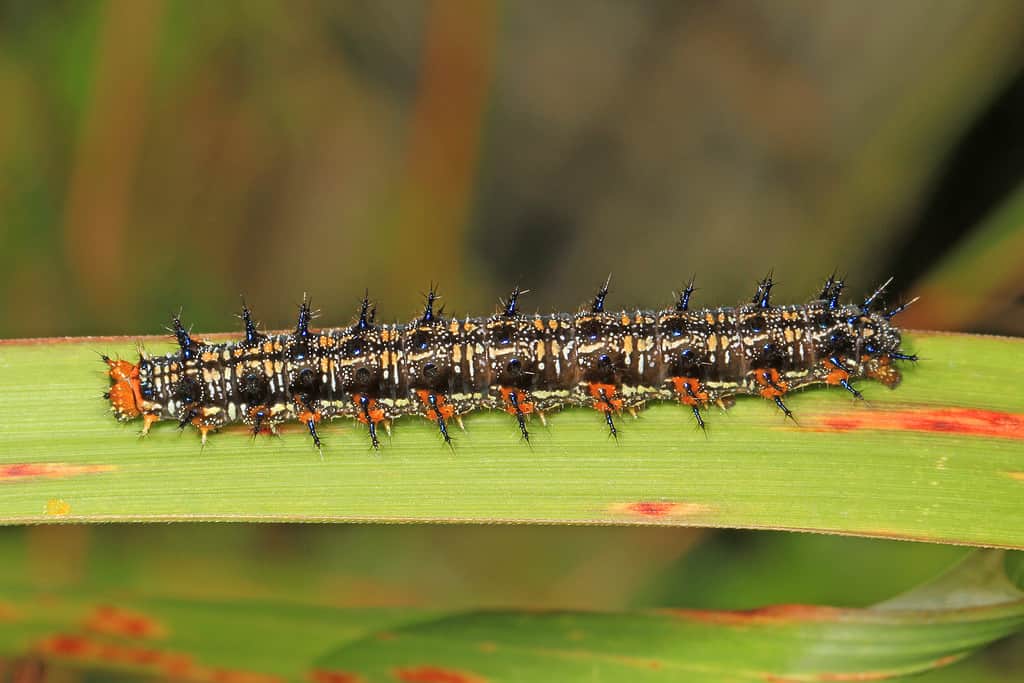
Interestingly, the common buckeye caterpillar prefers solitude.
©Judy Gallagher / CC BY 2.0 – License
The common buckeye butterfly caterpillar thrives in open spaces with sparse vegetation. Typically measuring around 1.5 inches, their black bodies feature light patterns in shades of white, gray, and beige, complemented by white streaks and orange dots on the sides.
Unlike many caterpillars that cluster in groups, buckeye caterpillars prefer solitude. They primarily feed on the weed plantain and the vibrant-flowered Gerardia. These caterpillars also enjoy a diet of snapdragon, toadflax, and various local weeds.
Though the buckeye caterpillar has spines, they pose no harm to humans.
4. Luna Moth Caterpillar (Actias luna)

A caterpillar you may come across in Georgia is the Luna moth.
©iStock.com/ErikaMitchell
The luna moth caterpillar, often referred to as the American moon moth or a type of giant silk moth, can stretch up to 4 inches. Initially, a vibrant shade of green, as it matures, it starts to develop yellow and magenta spots.
These caterpillars have a preference for eating the leaves of walnut, hickory, and pecan trees.
Though their bright colors might give an impression of being harmful, there’s no cause for alarm. Both the moths and their caterpillars are entirely harmless to humans.
5. Red-Spotted Admiral Caterpillar (Limenitis arthemis)
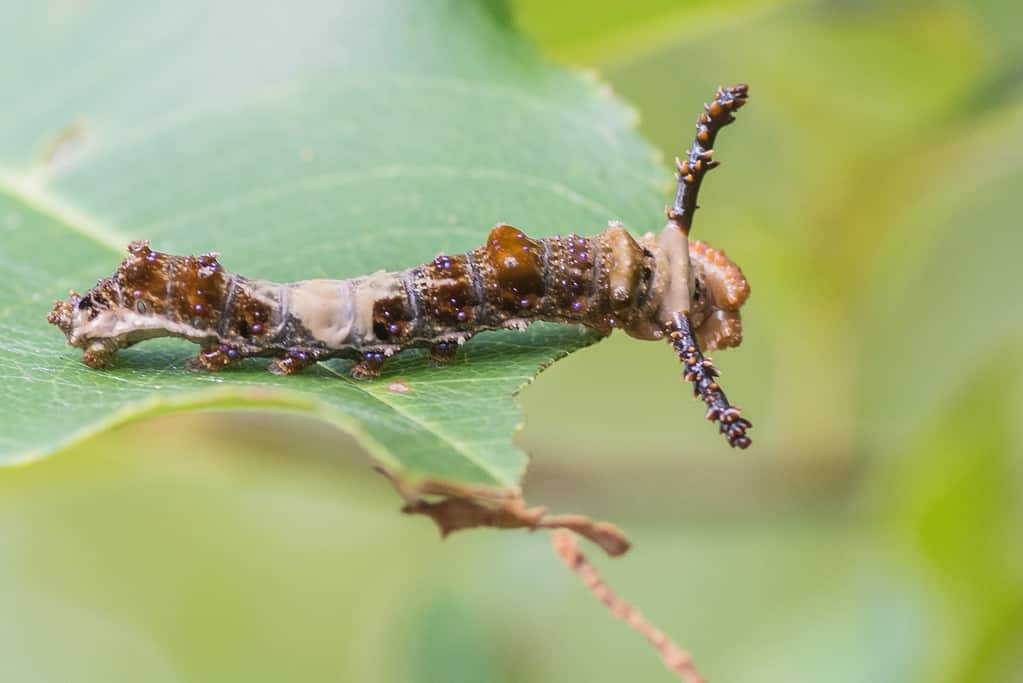
One of the more unique-looking caterpillars in Georgia is the red-spotted admiral.
©Andrew Cannizzaro / CC BY 2.0 – License
The red-spotted admiral caterpillar has a unique look that mimics bird droppings throughout its developmental stages. It can appear in shades of brown or green, adorned with creamy patterns and a pair of distinct horns on its thorax. To differentiate it from the viceroy caterpillar, take note of the rounded projections near its head instead of spikes.
Native to North America, these caterpillars primarily feast on willow, poplar, and aspen trees. Some of them prefer black cherry, while others opt for yellow birch.
Despite its intriguing appearance, this caterpillar is harmless and doesn’t pose any threat to humans.
6. Cloudless Sulphur Caterpillar (Phoebis sennae)
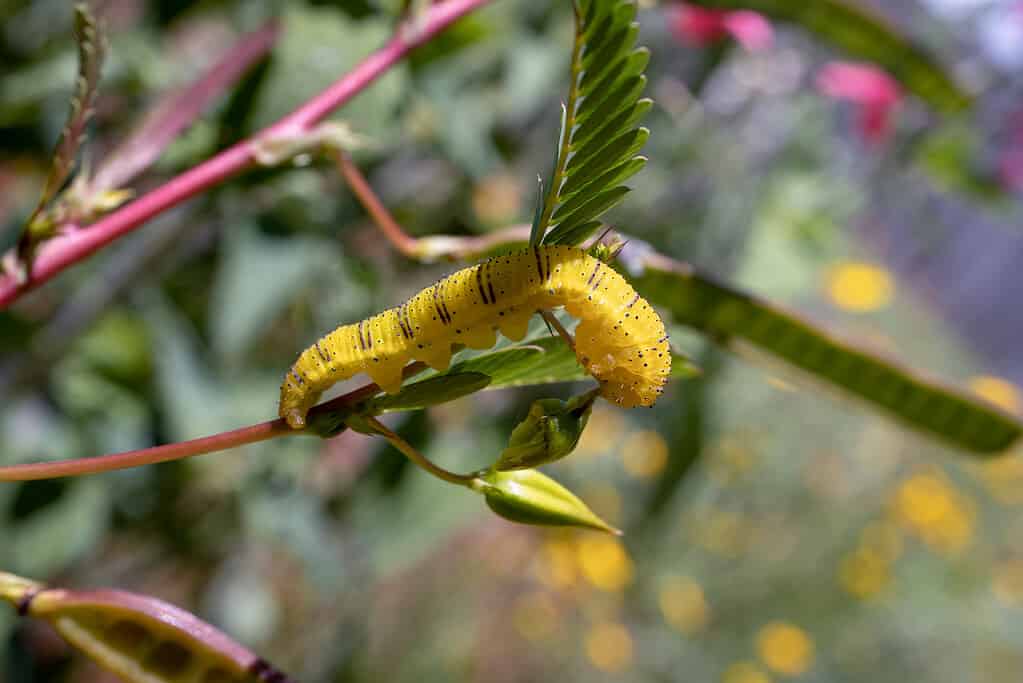
Coming in shades of yellow or green, cloudless sulphur caterpillars carry toxins.
©DrWD40/ via Getty Images
The cloudless sulphur is a butterfly characterized by its uniquely angled wings. When they first hatch, the caterpillars sport shades of yellow or green with side stripes. Additionally, they have a pattern of black spots lining their backs.
As they grow, these caterpillars munch on leaves and flowers, with a particular fondness for plants from the Senna and Cassia families. Since both these plants carry toxins, the caterpillars absorb these chemicals, making them a bitter and poisonous meal for potential predators.
7. Eastern Tent Caterpillar (Malacosoma americanum)
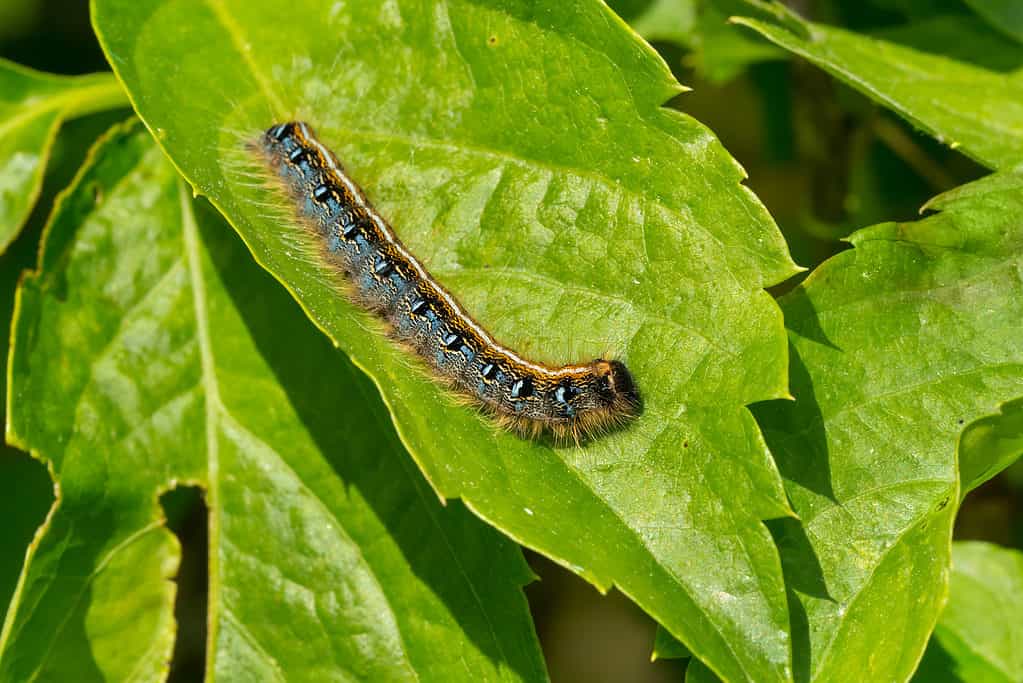
The eastern tent caterpillar loves to eat wild cherries, apples, and crabapple.
©Paul Reeves Photography/Shutterstock.com
In Georgia, the eastern tent caterpillar stands out as a highly sociable creature. These caterpillars team up by the hundreds, building communal nests, sharing warmth, and seeking food together.
Sporting a mix of blue, black, and orange hues and marked by a distinct line along their back, these caterpillars have soft bodies peppered with occasional tufts of hair along their sides. When they reach their full size, they measure about two inches.
Their preferred food? Leaves from wild cherry, apple, and crabapple trees.
Good news: these eastern tent caterpillars are harmless to us.
8. Imperial Moth Caterpillar (Eacles imperialis)

In its caterpillar stage, the imperial moth starts off orange and then turns to other colors, from green to brown and black.
©Matt Jeppson/Shutterstock.com
The imperial moth caterpillar is quite a sight. Starting life as orange critters just under half an inch, they’re quickly recognized by their striking black spines. As they grow, they transform into sizable caterpillars, ranging from green to brown and even nearing black, stretching up to 5 inches. Some brown variants might even sport vivid orange markings.
These caterpillars have a broad palate, feeding on various trees, but they show a particular fondness for pines, oaks, and maples.
A word of caution: their spiky exterior isn’t just for show. Those sharp spines contain a venom that, upon contact, can deliver a stinging sensation. Some individuals might even experience allergic reactions from these encounters.
9. Pearl Crescent Caterpillar (Phyciodes tharos)
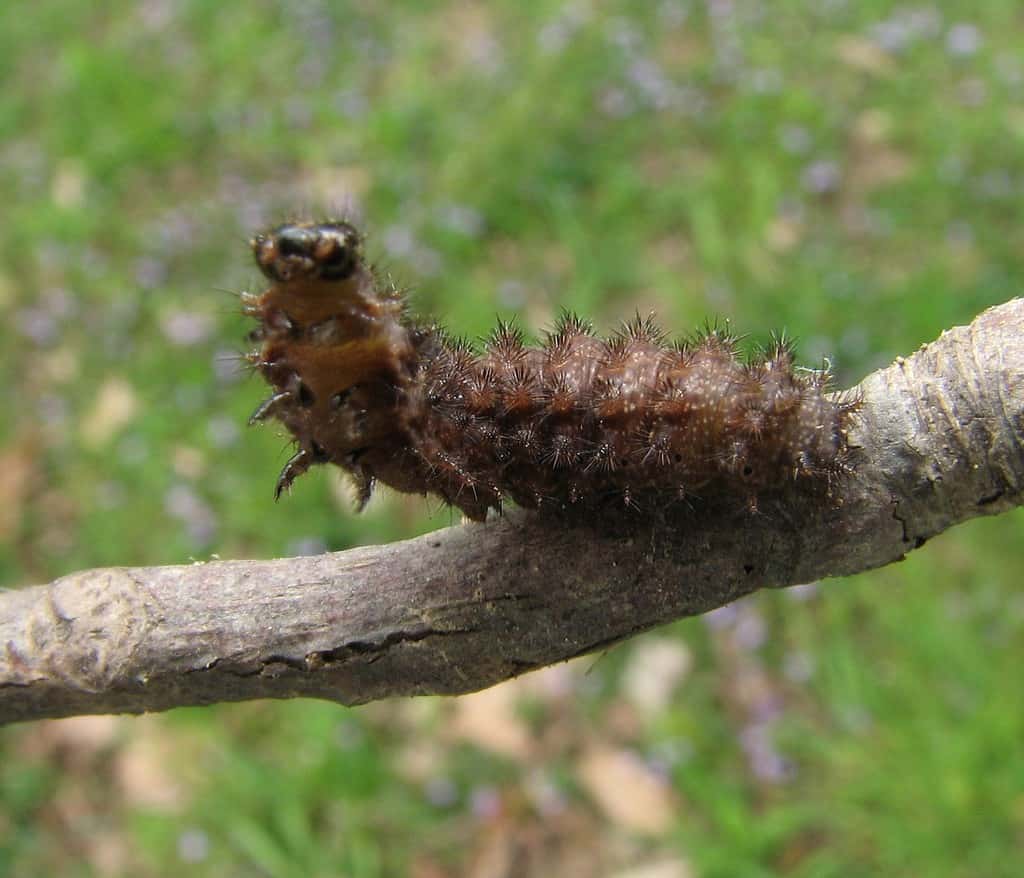
Found across Georgia, the pearl crescent caterpillar is harmless.
©Beatriz Moisset / CC BY-SA 3.0 – License
The pearl crescent caterpillar is a captivating sight commonly seen across Georgia’s open spaces, from roadsides to meadows and light pine forests. The caterpillar‘s appearance ranges from a deep brown to a smoky gray, adorned with pale cream-colored stripes on its sides and dotted with numerous tiny, branched spikes. In their early stages, these caterpillars have a habit of feeding in groups. Their diet mainly consists of Asters.
Don’t worry if you come across one of these; they’re harmless and not poisonous!
10. Yellow-Striped Oakworm Caterpillar (Anisota peigleri)
The yellow-striped oakworm caterpillar can grow up to 2 inches when mature. They boast a striking black hue paired with vibrant yellow lines. Notably, they have black protrusions stemming from their second thoracic section, and right behind each of these, you can spot a line of tiny spikes.
In their early life, these caterpillars cluster together, munching mainly on the softer parts of leaves, leaving them almost bare.
Although mature caterpillars have thorny structures on them, they’re harmless and won’t cause any harm to humans.
11. Fall Webworm Caterpillar (Hyphantria cunea)
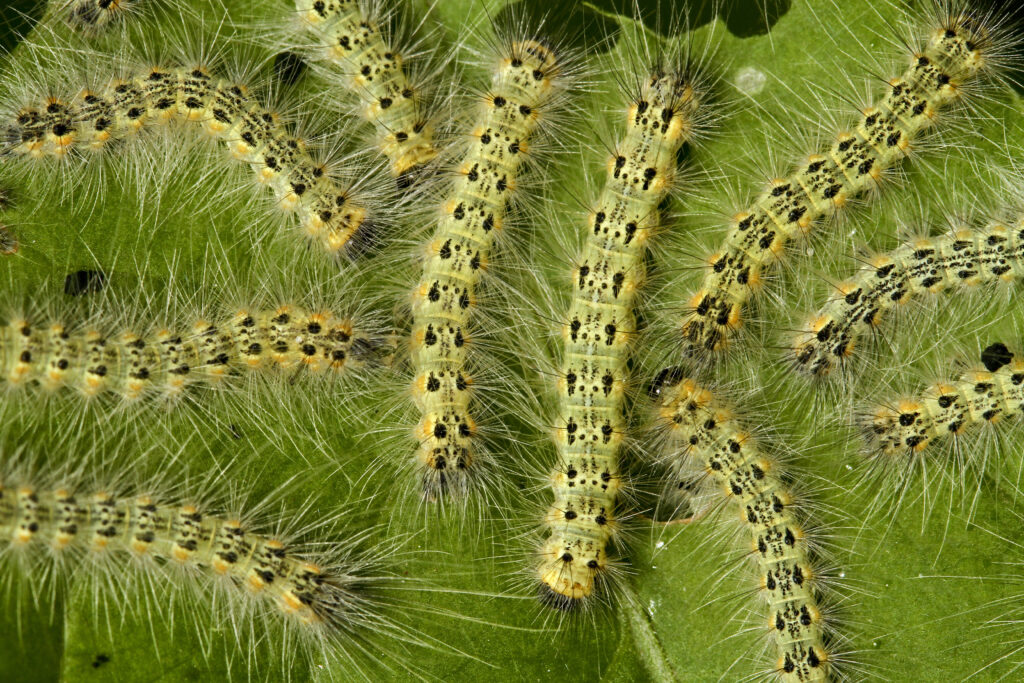
A fuzzy caterpillar, the fall webworm is surprisingly not toxic or poisonous.
©Geza Farkas/Shutterstock.com
The fall webworm is a common caterpillar in Georgia known to feast on decorative plants and trees. The mature fall webworm moth is easily recognizable by its bright white or yellow fuzzy appearance.
These caterpillars aren’t picky eaters. They’ll dine on close to 90 varieties of leaf-shedding trees, with favorites including hickory, walnut, birch, cherry, and crabapple.
Though they might weave their webs around your trees, there’s no need for alarm. Webworms won’t bite, and they’re safe to touch. They are mostly just an annoyance rather than a threat.
12. American Dagger Caterpillar (Acronicta americana)
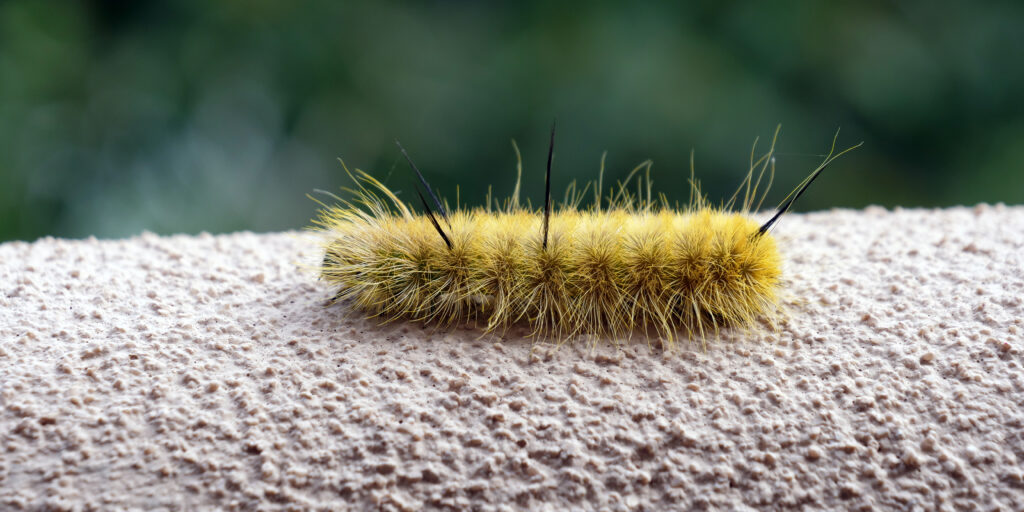
Although they may look fluffy and inviting to touch, American dagger moth caterpillars can sting and burn when touched!
©Martha Marks/Shutterstock.com
The American dagger moth caterpillar has a distinct fuzzy appearance, showcasing yellow to pale green or even white hairs. One of its distinguishing features includes four thin, black hair tufts sprouting from its first and third abdominal sections. There’s also another black tuft near its tail end.
These caterpillars have a diet that consists of leaves from trees like alder, ash, elm, and other hardwood varieties. You’ll commonly find them munching away in gardens, parks, forests, and even your backyard.
While their fluffy appearance might make them seem endearing, it’s best to avoid touching them. Their hairs can embed into the skin, resulting in itching, a burning sensation, and even skin rashes.
13. Pipevine Swallowtail Caterpillar (Battus philenor)

Commonly found on pipevines, the pipevine swallowtail caterpillar can grow up to 2 inches long.
©Sundry Photography/Shutterstock.com
The pipevine swallowtail caterpillar is commonly found wherever its favorite plant, the pipevine, thrives. This could be in forests, open fields, or even in residential gardens. These caterpillars can grow up to 2 inches and sport colors ranging from a rich reddish-brown to brown, often bordered with a hint of purple.
Though sometimes called blue swallowtails, these caterpillars exclusively dine on the leaves of birthworts and Dutchman’s pipes. What’s intriguing is that by feeding on their toxic host plant, the caterpillars become poisonous themselves!
14. Snowberry Clearwing Caterpillar (Hemaris diffinis)
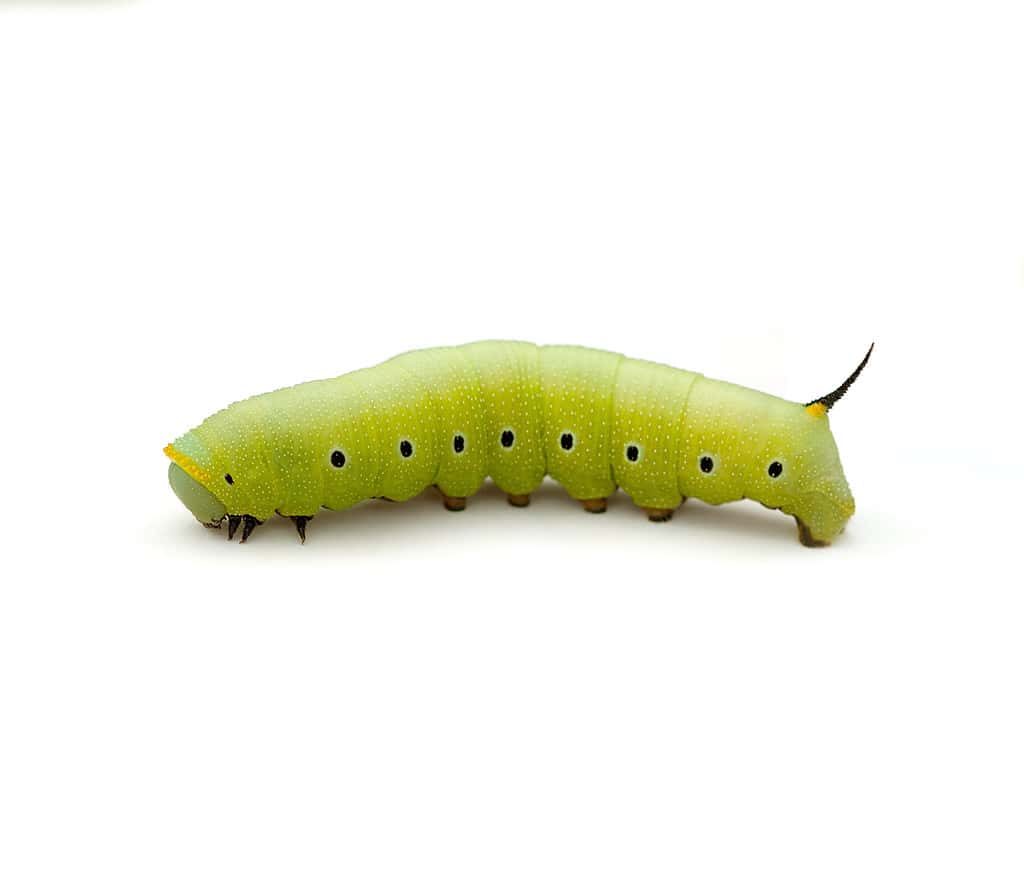
Boasting a bright green color, the snowberry clearwing moth caterpillar is non-toxic.
©epantha/iStock via Getty Images
The snowberry clearwing moth caterpillar boasts a vibrant green hue dotted with black spots near its breathing holes. A noticeable yellow band is present just behind its head, and it also features a black tail spike with a yellow foundation.
Young snowberry clearwings enjoy a varied diet, including plants like buck brush, snowberry, horse gentian, blue star, honeysuckles, and dogbanes.
These caterpillars pose no harm — they’re entirely non-toxic!
15. Rosy Maple Moth Caterpillar (Dryocampa rubicunda)

The rosy maple moth caterpillar goes through five developmental stages.
©ErikaMitchell/iStock via Getty Images
The caterpillar of the rosy maple moth — often called the green-striped mapleworms — goes through five developmental stages before reaching maturity. In their initial stages, these caterpillars showcase a predominantly dark head and a light yellow-green body accented by subtle green lines.
Their favorite meals are the leaves of maple, oak, and beech trees. Interestingly, when they mature into adults, they don’t eat at all.
While the adult moths are harmless (largely because they lack a proper mouth for biting), it’s wise to be cautious around the caterpillars. The rosy maple moth larvae can give a nasty, venomous prick or sting if touched!
16. White Furucla Moth Caterpillar (Furcula borealis)
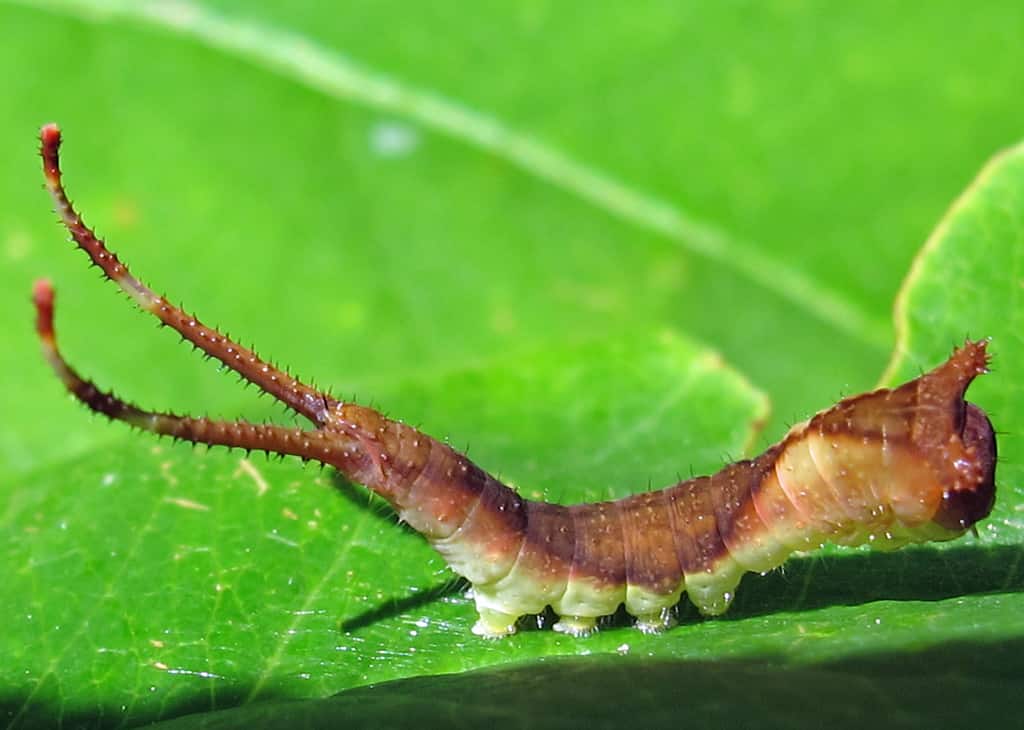
White furucla moth caterpillars are completely harmless, although they may look strange.
©Jacy Lucier / CC BY-SA 4.0 – License
Furculas, often active at night, are characterized by a distinct tuft of hair near their heads and upper bodies. The white furcula caterpillar can be identified by its yellow or green body, highlighted by a dark brown diamond-shaped mark at its center. This same brown hue graces its head and extends linearly towards a slender, split tail.
These caterpillars usually eat cherry, poplar, and willow leaves.
While they might look unique, there’s no cause for concern. The white furcula moth is harmless and doesn’t pose any risk to humans.
17. Tiger Moth Caterpillar (Arctia caja)
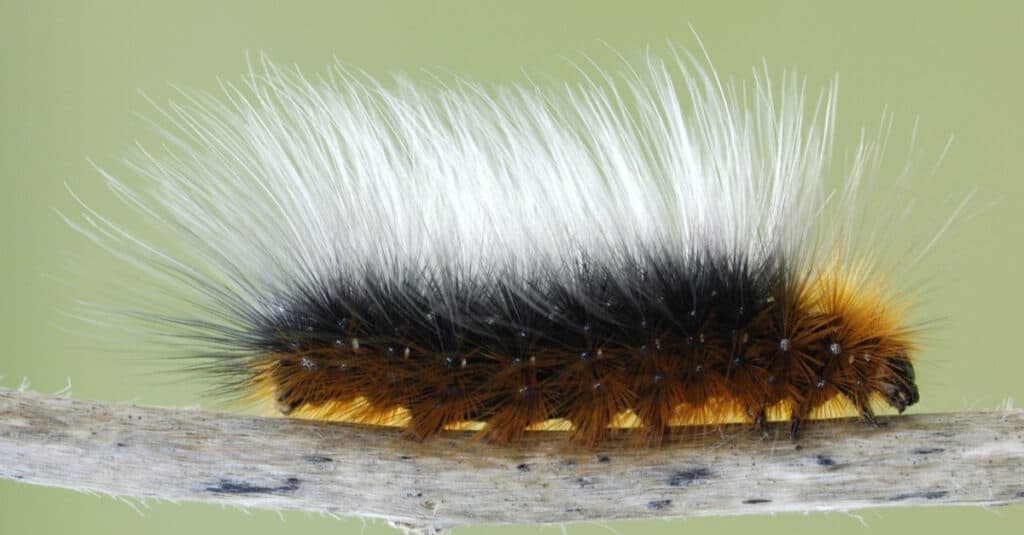
Tiger
moth caterpillars eat a wide range of wild plants and greens.
©Hugh Lansdown/Shutterstock.com
Caterpillars of the tiger moth are distinguishable by their large size, pitch-black color, and thick coating of black and ginger hairs.
While these caterpillars have an appetite for various wild plants and greens, the adult moths are nectar enthusiasts, drawing sustenance solely from the sweet essence of flowers.
Tiger moth caterpillars carry toxins potent enough to induce nausea, severe digestive issues, or even prove fatal in extreme situations. Some of these caterpillars are so toxic that they’re harnessed for pest control in farming.
18. Spun Glass Slug Caterpillar (Isochaetes beutenmuelleri)
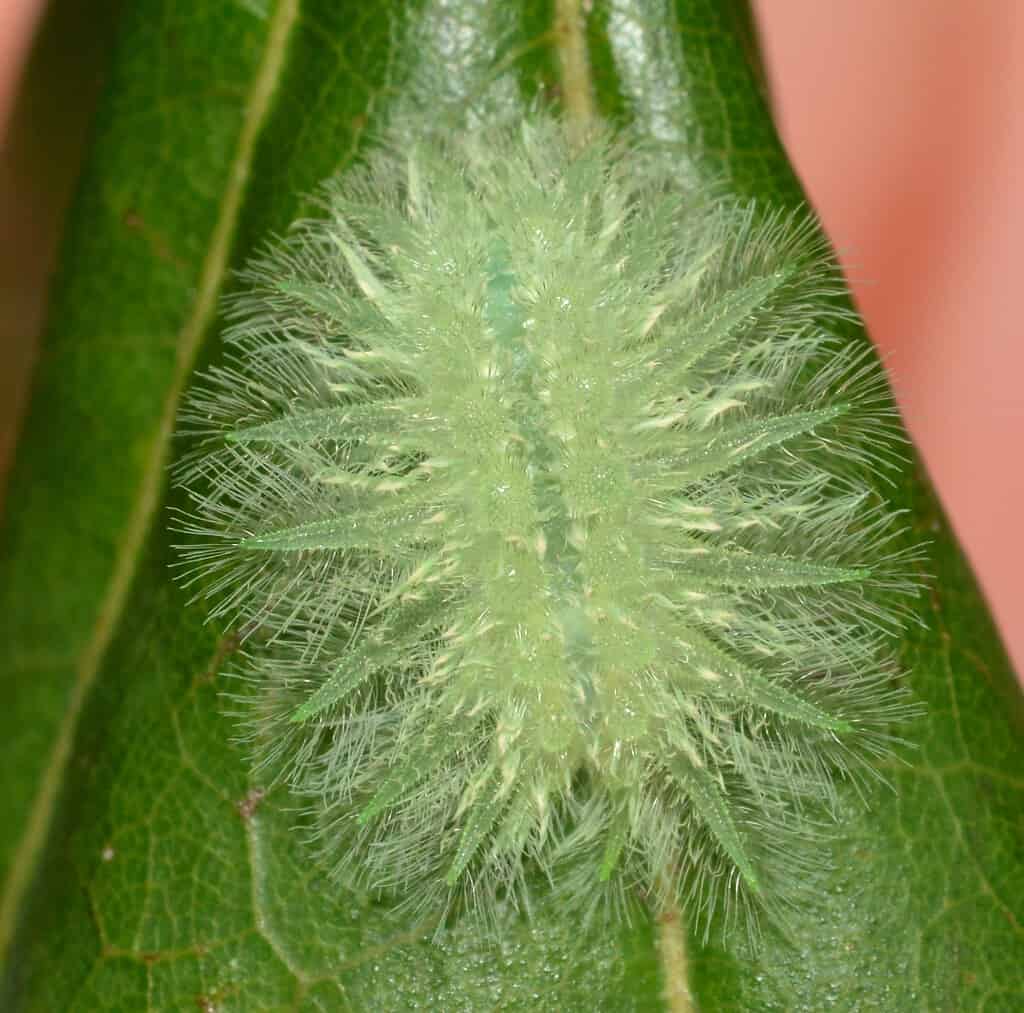
One of the most interesting-looking caterpillars in Georgia is the spun glass slug caterpillar.
©Andy Reago & Chrissy McClarren / CC BY 2.0 – License
The spun glass caterpillar has a remarkable appearance in its larval stage, with needle-thin spines that give off a translucent glow akin to delicate spun glass.
Its primary source of food is the swamp oak tree.
It’s essential to approach the spun glass slug caterpillar with caution. This caterpillar’s prickly hairs carry toxins that, when touched, can lead to skin irritations.
19. Stinging Rose Caterpillar (Parasa indetermina)
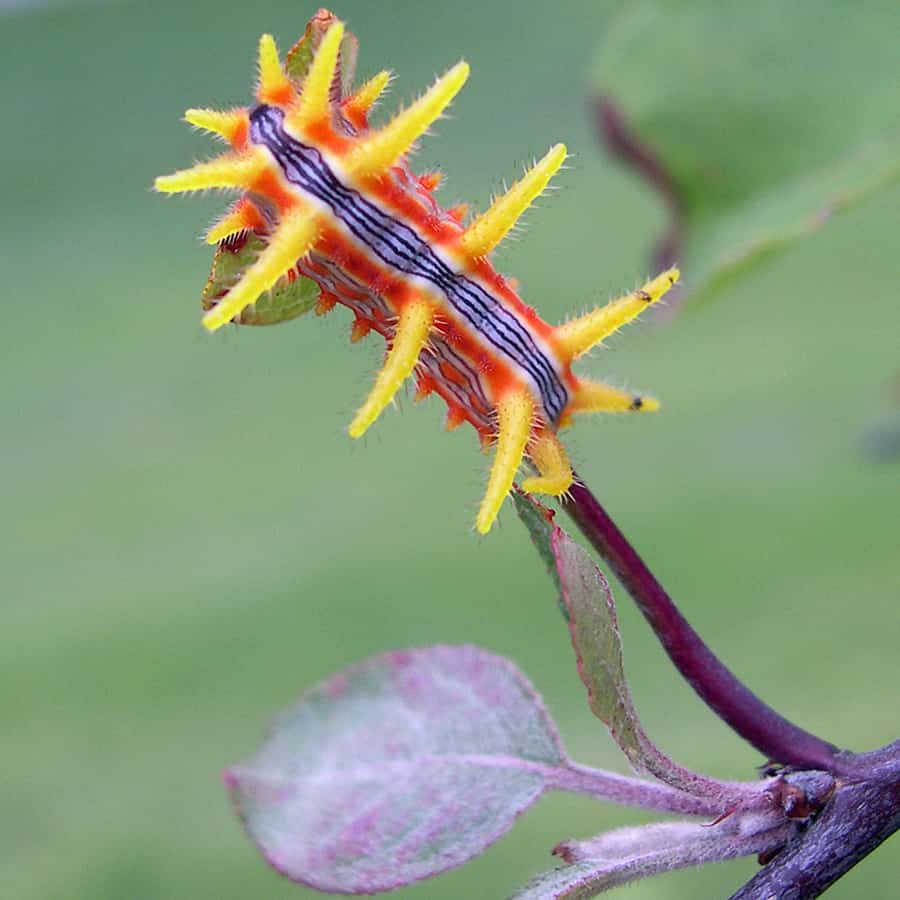
Beware of the bright color of the stinging rose caterpillar!
©M. Whitson / CC BY 4.0 – License
The stinging rose caterpillar has a unique appearance reminiscent of a piece of art made from colored glass. Its striking shades of yellow, red, purple, and orange are truly a sight to behold.
It’s known to feed on leaves from trees such as apples, dogwood, and hickory.
Unique to this caterpillar are its seven pairs of horn-like spines, accompanied by smaller prickly bumps on its sides. Each of these spines is hollow and filled with an irritating substance. If accidentally brushed against human skin, the spine’s tip can break, releasing the substance and resulting in a sharp sting.
20. Giant Leopard Moth Caterpillar (Hypercompe scribonia)
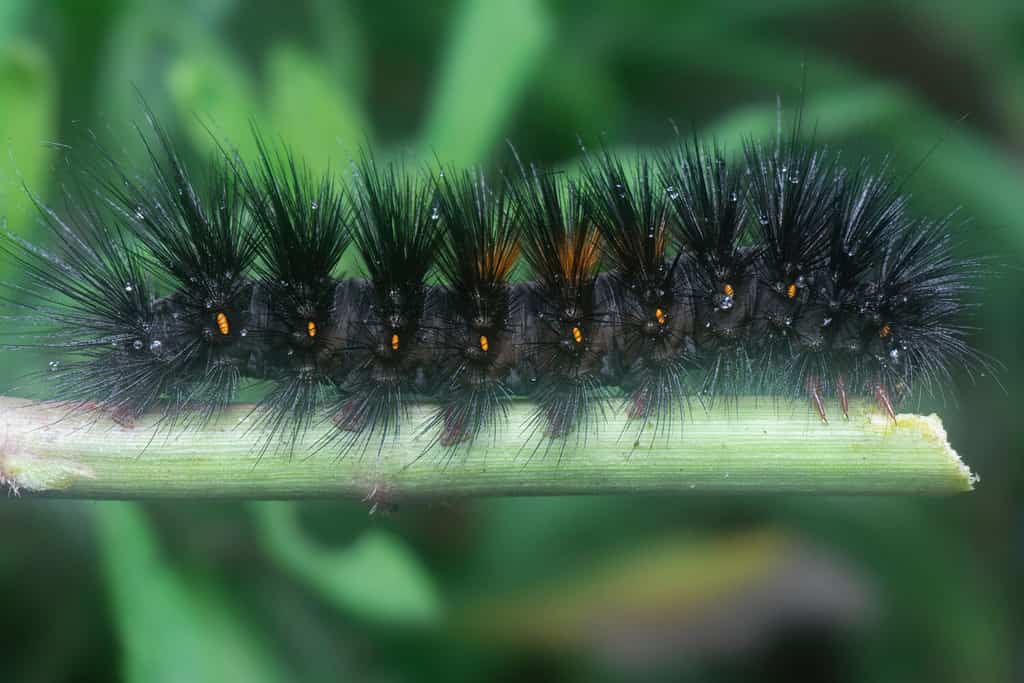
Boasting black hairs, giant
leopard
moth caterpillars look intimidating but are harmless.
©Young Swee Ming/Shutterstock.com
Giant leopard moth caterpillars, when fully grown, showcase a striking black hue with reddish gaps between their body segments. Each segment is adorned with firm black hairs that sprout from brownish nodules.
These caterpillars have a diverse palate, munching on leaves from plants such as dandelions, violets, honeysuckle, and even citrus varieties.
Despite their intimidating appearance with all those bristles, these caterpillars are entirely harmless and pose no threat.
Regions in Georgia with the Most Caterpillars
Georgia, with its varied landscapes and mild climate, is a haven for many species of caterpillars. Here’s a glimpse of regions in the state that are particularly caterpillar-rich:
- Chattahoochee National Forest: This vast expanse, covering over 750,000 acres, is not just mountainous beauty. Its dense forests and varied plant life offer the perfect home for many caterpillar species.
- Coastal Plain Region: The region’s warm, moist climate and diverse range of habitats, from pine woods to wetlands, make it a caterpillar paradise.
- Piedmont Region: Its blend of grasslands and woodlands provides a buffet of plant species for caterpillars to munch on.
- Blue Ridge Region: Its higher elevations and cool, moist forests create an environment for some caterpillar species not found in many other parts of Georgia.
- City Parks: Various well-maintained city parks offer a variety of plants that attract caterpillars. With their expansive green spaces and variety of trees, they are hotspots for butterflies and moth caterpillars.
Summary of 20 Caterpillars Found in Georgia
| Number | Caterpillar | Type of Caterpillar | Poisonous/Venomous? |
|---|---|---|---|
| 1 | Army Cutworm Caterpillar | Moth | No |
| 2 | Gulf Fritillary Caterpillar | Butterfly | Yes |
| 3 | Common Buckeye Caterpillar | Butterfly | No |
| 4 | Luna Moth Caterpillar | Moth | No |
| 5 | Red-Spotted Admiral Caterpillar | Butterfly | No |
| 6 | Cloudless Sulphur Caterpillar | Butterfly | Yes |
| 7 | Eastern Tent Caterpillar | Moth | No |
| 8 | Imperial Moth Caterpillar | Moth | Yes |
| 9 | Pearl Crescent Caterpillar | Butterfly | No |
| 10 | Yellow-Striped Oakworm Caterpillar | Moth | No |
| 11 | Fall Webworm Caterpillar | Moth | No |
| 12 | American Dagger Caterpillar | Moth | Yes |
| 13 | Pipevine Swallowtail Caterpillar | Butterfly | Yes |
| 14 | Snowberry Clearwing Caterpillar | Moth | No |
| 15 | Rosy Maple Moth Caterpillar | Moth | No |
| 16 | White Furcula Moth Caterpillar | Moth | No |
| 17 | Tiger Moth Caterpillar | Moth | Yes |
| 18 | Spun Glass Slug Caterpillar | Moth | Yes |
| 19 | Stinging Rose Caterpillar | Moth | Yes |
| 20 | Giant Leopard Moth Caterpillar | Moth | No |
The photo featured at the top of this post is © Jerry Morse/iStock via Getty Images
Thank you for reading! Have some feedback for us? Contact the AZ Animals editorial team.






